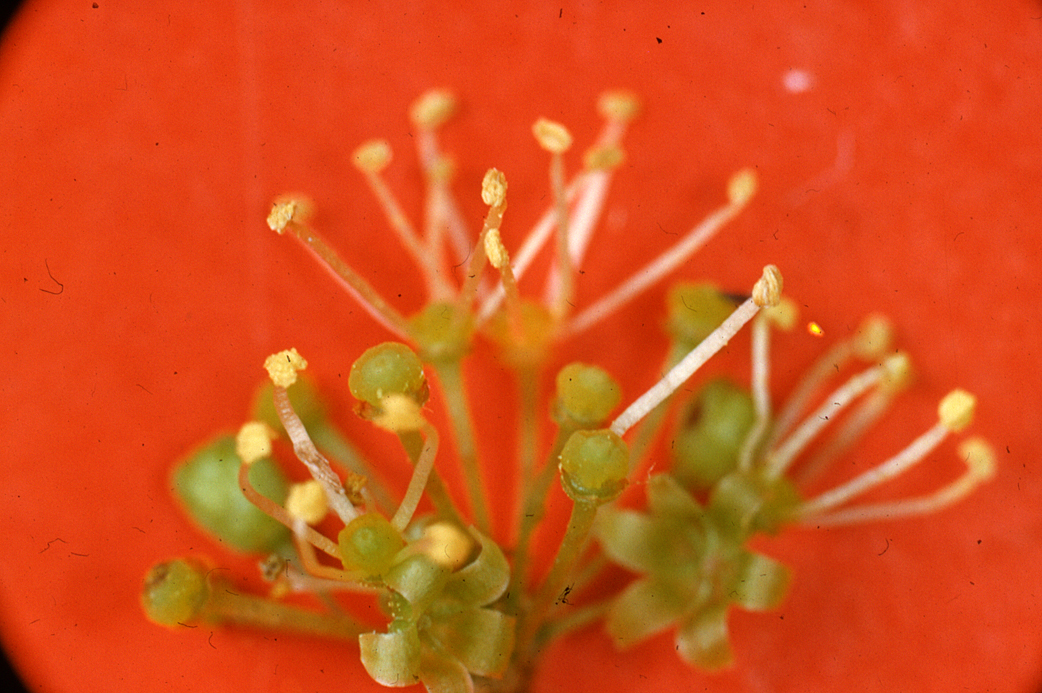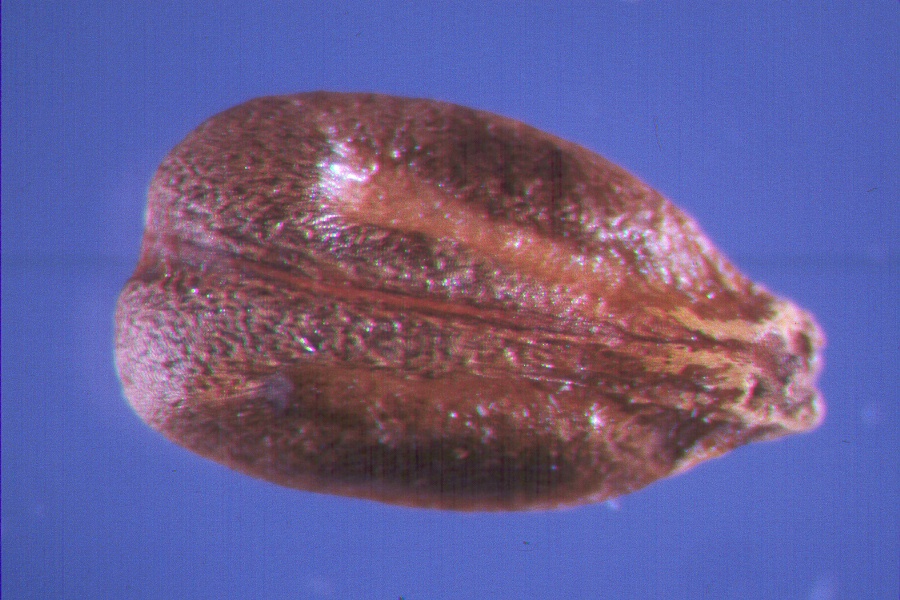 Download PDF
Download PDF
Name: Vitis labrusca L.
Family: Vitaceae, the Grape Family
Common Names: Fox grape, northern fox grape, labruscan vineyard grape
Etymology: Vitis is Latin for grapevine. Labrusca is the Latin word for grape; it may have originally referred to the wild grape vine (2,7).
Botanical synonyms:
V. labruscana Bailey (3).
V. vinifera var. labrusca (L.) Kuntze
Cissus labrusca (L.) Kuntze (11)
Quick Notable Features:
¬ Simple, alternate, three-lobed leaves
¬ Leaves undersides completely covered in brown pubescence
¬ Sweet berries at least 15mm in diameter (5, 7)
Plant Height: Climbs up to 12m (12).
Subspecies/varieties recognized: Vitis. labrusca L. var. subedentata Fern., V. labrusca var. aestivalis (Michx.) Regel, V. labrusca var. alba Prince, V. labrusca var. dissecta Demcker, Vitis labrusca var. ficifolia (Bunge) Regel, V. labrusca var. labrusca, V. labrusca var. labruscoides Eaton, V. labrusca var macrophylla Demcker, V. labrusca var. rosea Prince, V. labrusca var.thunbergii Franch. & Sav.
Vitis labrusca is extensively cultivated. The Concord, Champion, Chautauqua, Moore’s Early, and many others cultivated grape varieties in the eastern U.S. are hybrids of V. labrusca with others, and are collectively known V. labruscana L. H. Bailey (5, 7,13, 17).
Most Likely Confused with: May be confused with other Vitis species as well as other Vitaceae species such as Parthenocissus tricuspidata and Ampelopsis brevipedunculata. Leaves may look similar to those of cucurbit genera like Echinocytis and Sicyos. Occasional deeper-lobed leaves may resemble Humulus.
Habitat Preference: Lowland to upland forests, esp. disturbed habitats: thickets, roadsides, fencerows, and even meadows or sandy hills (5).
Geographic Distribution in Michigan: Found in Washtenaw and Oakland counties in southeastern Michigan. Prevalent in southwestern Michigan, especially counties along Lake Michigan. Also reported in Marquette county in the Upper Peninsula. In Canada, it is found in NB, NS, and ON (1,5).
Known Elevational Distribution: Reported in Utah, approx. 1,400m (1).
Complete Geographic Distribution: Native to North America. Found in all states east of the Mississippi River, with the exception of Florida. Also reported in Utah (1).
Vegetative Plant Description: High-climbing perennial liana. The bark is distinctively shredding and without lenticels; the pith is brown and interrupted at nodes by a diaphragm. The Young branches, petioles and tendrils are rusty pubescent. Leaves 10-20cm long and broad, simple, alternate, orbicular to cordate, variably toothed, and almost always 3-lobed. Leaf lobes are typically shallow and more or less forward-pointing. Leaves are thick and display strong palmate venation. Leaf undersides are permanently and completely covered in brown pubescence (5, 6, 7, 10, 18).
Climbing Mechanism: Plant climbs using bifid axillary tendrils opposite the leaves. Tendrils or inflorescences are present at three or more successive nodes (6, 10).
Flower Description: Flowers are borne in groups of 20 or fewer on ovoid axillary  panicles 4-8cm long. Flowers are perigynous, 5-merous, green, and incomplete: the calyx is essentially missing. Stamens are 5, opposite the petals, and can be elongate to short and erect to reflexed, if the flower is sterile or fertile, respectively. Pistils are rudimentary to well-developed depending on fertility. The superior ovary is 2-celled with 2 ovules per cell. Styles are short; stigmas are 2-lobed (6, 7, 10). As an interesting side note, grape floral characteristics are highly conserved; vegetative characters are much more useful in distinguishing between species, unlike most other plants (5).
panicles 4-8cm long. Flowers are perigynous, 5-merous, green, and incomplete: the calyx is essentially missing. Stamens are 5, opposite the petals, and can be elongate to short and erect to reflexed, if the flower is sterile or fertile, respectively. Pistils are rudimentary to well-developed depending on fertility. The superior ovary is 2-celled with 2 ovules per cell. Styles are short; stigmas are 2-lobed (6, 7, 10). As an interesting side note, grape floral characteristics are highly conserved; vegetative characters are much more useful in distinguishing between species, unlike most other plants (5).
Flowering Time: Mid-May through early July in Northeastern United States (7).
Pollinator: Flowers are bee- and self-pollinated (9).
Fruit Type and Description: Fruits develop in September and October. The fruit is a dark red to black, sweet berry 15-25mm in diameter. In forma alba, the fruits can be amber-white to pink. Fruits are borne in axillary panicles (6, 7, 10, 18).
Seed Description: Seeds are rounded with a short beak, 5-8mm long and 4-6mm broad (1, 7).
Dispersal Syndrome (and evidence): Bird and mammal dispersed (12).
Distinguished by: V. labrusca may be distinguished from Parthenocissus tricuspidata, Ampelopsis brevipedunculata, and Cucurbitaceae species by the rust-colored tomentum completely concealing the undersurface of the leaf. Occasionally deeper-lobed leaves can be distinguished from Humulus by the presence of only three lobes and the alternate leaf arrangement of V. labrusca.
Other members of the family in Michigan (number species): Vitis (3), Ampelopsis (3), Parthenocissus (3).
Ethnobotanical Uses: Leaves, roots, and bark are used to treat diarrhea, ‘bad blood’, liver problems, irregular urination, and breast soreness after childbirth. Poultices of leaves can be applied for topical pain relief or fever. Decoctions of roots can be mixed  with horse feed as a veterinary aid. Fruits are made into beverages, breads, and cakes, or simply eaten raw (4).
with horse feed as a veterinary aid. Fruits are made into beverages, breads, and cakes, or simply eaten raw (4).
Phylogenetic Information: Vitaceae is a core eudicot within the larger Rosids. The Vitaceae are now placed in the order Vitales (APGIII). Vitales may be a sister group to all the Rosids. Vitaceae is most closely related to the Crossosomatales, Geraniales, and Myrtales (8, 16).
 Interesting Quotation or Other Interesting Factoid not inserted above:
Interesting Quotation or Other Interesting Factoid not inserted above:
V. labrusca is the eastern counterpart to V. vinifera L., the Old-World wine grape that’s extensively cultivated in California (5).
The word “labrusca” is presumably Latin in origin. It originally meant wild grape vine (7). It is mentioned in a few classics including the Bucolica and the Culex.
The origin of the name “fox grape” is unclear. “Foxy” supposedly describes the distinct flavor of the grapes, but this does not explain the association between foxes and grapes. Some have suggested that the sharp flavor of the fruits, when compared to the old-world grape V. vinifera, was so unpleasant to early growers that they attached names such as “fox” and “skunk” (14). However, the link between foxes and grapes can be seen in early literature such as Aesop’s Fables and the Song of Solomon, and thus the exact origin of the association may be deeply rooted in Western civilization.
Vitis tendrils and inflorescences grow at the same location (at nodes, opposite leaves) and their presences are mutually exclusive (either one or the other, not both). The two different structures develop from the same undifferentiated axillary primordia, which default into inflorescences. Interestingly, gibberellins, which normally stimulate flowering in plants, are responsible for the conversion of developing inflorescences into tendrils and the elongation of stem internodal zones in Vitis. This is crucial to the climbing habit of grapes (15).
Literature and websites used:
- USDA, NRCS. 2006. The PLANTS Database (http://plants.usda.gov, 8 November 2006). National Plant Data Center, Baton Rouge, LA 70874-4490 USA.
- Charters, M.L. 2006. Calflora – California Plant Names. A Dictionary of Botanical Etymology. http://www.etymologie.info/~e/u_/us-__ca__.html
- Iverson, L., D. Ketzner & J. Karnes. 2006. Vitis labrusca. Illinois Plant Information Network. http://www.fs.fed.us/ne/delaware/ilpin/ilpin.html
- Moerman, D. 2006. Native American Ethnobotany. University of Michigan – Dearborn. http://herb.umd.umich.edu/
- Voss, E.G. 1985. Michigan Flora Part II. Ann Arbor: University of Michigan.
- Gleason, H.A. 1963. Illustrated Flora of the Northeastern United States and Adjacent Canada, Volume 2. New York: Hafner Publishing Company, Inc.
- Fernald, M.L. 1950. Gray’s Manual of Botany, eighth edition. New York: American Book Co.
- APG II 2003. Update of the Angiosperm Phylogeny Group classification for orders and families of flowering plants: APG II. Botanical Journal of the Linnean Society. 141(4): 399-436.
- McGregor, S.E. 1976. Small Fruits and Brambles. In Insect Pollination of Cultivated Crop Plants. http://gears.tucson.ars.ag.gov/book/
- Gleason, H. A. & A. Cronquist. 1991. Manual of Vascular Plants of Northeastern United States and Adjacent Canada. New York: The New York Botanical Garden Press.
- Solomon, J. 2006. W3TROPICOS VAST nomenclatural database. Missouri Botanical Garden. http://mobot.mobot.org/W3T/Search/vast.html
- Bonner, F.T. 2006. Vitis labrusca L. USDA Forest Service. http://www.nsl.fs.fed.us/wpsm/Vitis.pdf
- Cooperrider, T.S. 1995. The Dicotyledons of Ohio – Part 2. Linaceae through Campanulaceae. Columbus: Ohio State University Press.
- Birnbaum, B. 2005. Strange fruit – The nativist roots of America’s quintessential Jewish wine. from: The Boston Globe. http://www.boston.com/news/globe/ideas/articles/2005/04/24/strange_fruit/
- Boss, P. K. & M. R. Thomas. 2002. Association of dwarfism and floral induction with a grape ‘green revolution’ mutation. Nature 416: 847-850.
- APG III (2009). An update of the Angiosperm Phylogeny Group classification for the orders and families of flowering plants: APG III. Bot. J. of the Linnean Society 161: 105–121.
- Tropicos.org. Missouri Botanical Garden. 29 December 2012. http://www.tropicos.org/Name/34000022
- Britton, N.L. & H.A. Brown 1970. An Illustrated Flora of the Northern United States and Canada: Volume I. New York, NY: Dover Publications, Inc.
Image Credits (all used with permission):
1. General habit image from Missouri Botanical Gardens. http://www.mobot.org/gardeninghelp/images/low/N530-0901020.jpg
2. Leaf close view image © Keith Weller, USDA Agricultural Research Service, Bugwood.org
3. Flower image from Randolph Taylor Slide collection, University of Michigan Herbarium, scan from CLIMBERS project of Robyn J. Burnham
4. Fruit picture copyright of the UBD Botanical Garden via permission by Phillip Lacock http://www.ubcbotanicalgarden.org/potd/vitis-labrusca-concord.jpg
5. Seed image from Woody Plant Seed Manual, USDA Seed Laboratory, http://www.nsl.fs.fed.us/wpsm/Vitis_labrusca.jpg
6. Species distribution map, derived from the Michigan Flora Online.
Primary Author: Susu Yuan, with editing and additions by John Bradtke and Robyn J. Burnham
© Robyn J. Burnham, University of Michigan
For additional information on Michigan Plant Diversity web pages please contact Robyn J. Burnham via email: rburnham“at”umich.edu